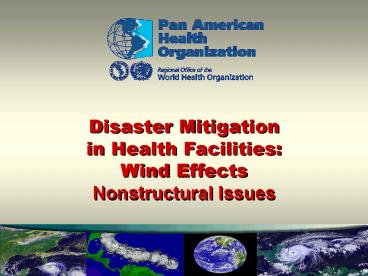Disaster%20Mitigation - PowerPoint PPT Presentation
Title:
Disaster%20Mitigation
Description:
Office equipment. Medical and industrial gases. Air conditioning. Electrical generator ... Essential: Similar to indispensable equipment, except that it can be ... – PowerPoint PPT presentation
Number of Views:145
Avg rating:3.0/5.0
Title: Disaster%20Mitigation
1
Disaster Mitigation in Health Facilities Wind
Effects Nonstructural Issues
2
Nonstructural elements to consider when assessing
vulnerability
ARCHITECTURAL
EQUIPMENT
BASIC INSTALLATIONS
- Façades
- Roof covers
- Parapets
- Chimneys
- Plaster
- Glass windows
- Attachments (signs, antennae,etc)
- Ornaments
- Canopies
- Railings
- Doors and exit routes
- Medical equipment
- Industrial equipment
- Supplies
- Office equipment
- Medical and industrial gases
- Air conditioning
- Electrical generator
- Hydraulic networks
- Electric networks
3
Nonstructural vulnerability assessment methods
- Previous experience
- Visual inspection
- Data collection
- Non-destructive tests
- Mathematical models
- Structural analysis and design
- Wind tunnel analysis
- Retrofitting recommendations
- Equipment classification
4
Standards and codes must cover components and
claddings
The trend for international standards is to adopt
and adapt the ASCE-7 approach for components and
claddings.
5
Design pressure for components and cladding and
design force for special and open structures
(ASCE-7)
Design pressure
Design force
6
Criteria for equipment classification
Indispensable Equipment that can not easily or
economically be replaced and is essential for the
provision of health services. Essential Similar
to indispensable equipment, except that it can
be replaced easily or cheaply. Hazardous Equipmen
t that can injure people and damage
objects. Chaotic Equipment whose failure may
cause disruption to its environs. Functional Eq
uipment that is not used for emergency health
care.
7
Hipped roof recommended over flat roof
8
Gabled roof with slopes of 20 to 30 degrees are
preferred against hurricanes
Hatched area indicates
where more frequent
fixings are required
PLAN
ISOMETRIC
Gabled roof
9
Connection details between metal sheet roof and
purlins
10
Typical connection system between metal sheet
roof and masonry wall
11
Nonstructural elementsare not designed to resist
direct loads
Failure of an unreinforced masonry wall without
an adequate base anchorage
12
Shutters protect against the penetration of
flying objects and water
13
For a hospital it is essential to have protection
against penetration of windborne debris and water
14
Anchorage of protective shutters on outside walls
15
Anchorage system of shutters on interior columns
16
Exterior doors must be protected against internal
and external pressures through adequate anchorages
17
Window deformations due to the impact of
windborne debris
18
Impact of windborne debris against louvre windows
19
An unprotected window is vulnerable in the event
of a hurricane
20
Roll-up or permanent shutters are the best way to
protect windows against hurricanes
21
Permanent window shutter details
22
Details of roll-up shutter
23
Adequate anchorage of hospital equipment will
ensure continuous service
24
An example of good anchorage on exterior hospital
equipment
25
Exterior equipment should be anchored with
special bands
26
External oxygen and gas tanks should not be loose
27
Correct anchorage of external oxygen and gas
tanks to walls
28
Restraints and fasteners for larger external
equipment
29
Failure of a metallic roof cover and an
unreinforced masonry wall
30
Metal sheet roof of a health center was destroyed
by hurricane-force winds
31
Damage to the façade due to failure of a
neighboring building
32
Windborne debris on a structure
A roof from a structure located 100 m away was
violently thrown by the strong winds of a
hurricane
33
Impact of windborne debris on a plywood hurricane
shutter
34
Windborne debris perforates shutter and glass
behind it
35
Health center damaged by a water tank thrown by
hurricane winds
36
? Pan American Health Organization, 2005 These
slides have been made possible through the
financial support of the Disaster Preparedness
Program of the Humanitarian Aid Office, ECHO
(DIPECHO-III)
Ph (809) 567-9271 Fax (809) 566-3200 danielc_at_in
tec.edu.do www.intec.edu.do
Grupo de Estabilidad Estructural (Ge2) /
INTEC Ave Los Próceres, Galá Apdo 349-2 Santo
Domingo, Dominican Republic































